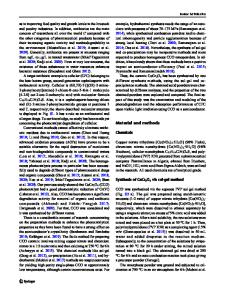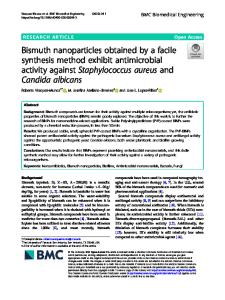Novel Mg@ZnO nanoparticles synthesized by facile one-step combustion route for anti-microbial, cytotoxicity and photocat
- PDF / 4,739,761 Bytes
- 17 Pages / 595.276 x 790.866 pts Page_size
- 19 Downloads / 322 Views
ORIGINAL RESEARCH
Novel Mg@ZnO nanoparticles synthesized by facile one‑step combustion route for anti‑microbial, cytotoxicity and photocatalysis applications Mohamed S. Hamdy1 · Kamlesh V. Chandekar2 · Mohd. Shkir3 · S. AlFaify3 · Essam H. Ibrahim4,5,6 · Zubair Ahmad5,7,8 · Mona Kilany5,9 · Badria M. Al‑Shehri1 · Khadijah S. Al‑Namshah1 Received: 17 July 2020 / Accepted: 16 September 2020 © Islamic Azad University 2020
Abstract Nanoscale materials are of a foremost desirability in functionalized materials research in almost all areas of science. Nanoscale materials with good biocompatibility and chemical stability possess biomedical usages which comprises drug carrier, cell/DNA parting, wastewater cleaning etc. Hence, magnesium-doped ZnO (Mg@ZnO) nanoparticles (NPs) were prepared by combustion route. Crystallization of Mg@ZnO NPs was investigated using X-ray diffraction and transmission electron microscopy. The particle sizes were in the range of 50–130 nm and 17.5–52.5 nm for x = 1 wt% and 4 wt% in MgxZn1-xO samples, respectively. The Z n2+ substitution by M g2+ in ZnO increased oxygen vacancies and reduced free electrons concentration. The concentrations of dopant dependent optical band gaps were calculated using diffuse reflectance and found in the range of 3.258–3.278 eV. Antibacterial study of Mg@ZnO NPs was conducted against the Gram- + ve and Gram – ve bacteria and results revealed enrichment in antibacterial activity of Mg@ZnO NPs against all types of bacteria. In vivo test revealed that all Mg@ZnO NPs have no cytotoxic effects on liver and kidneys. Furthermore, photocatalytic activity was performed towards hazardous methylene green dye degradation under UV light irradiation. The presence of Mg in ZnO lattice remarkably improved its photocatalytic performance and the photocatalytic activity of Mg@ZnO ranged from 1.8 to 5.4 times higher than the activity of neat ZnO under the same reaction conditions.
Electronic supplementary material The online version of this article (https://doi.org/10.1007/s40097-020-00355-9) contains supplementary material, which is available to authorized users. * Mohd. Shkir [email protected] * S. AlFaify [email protected] 1
2
3
4
Department of Chemistry, Catalysis Research Group (CRG), College of Science, King Khalid University, PO Box 9004, Abha 61413, Saudi Arabia Department of Physics, Rayat Shikshan Sanstha’s, Karmaveer Bhaurao Patil College, Vashi, Navi Mumbai 400703, India Department of Physics, Faculty of Science, Advanced Functional Materials and Optoelectronics Laboratory (AFMOL), King Khalid University, Abha 61413, Saudi Arabia
5
Research Center for Advanced Materials Science (RCAMS), King Khalid University, P.O. Box 9004, Abha 61413, Saudi Arabia
6
Blood Products Quality Control and Research Department, National Organization for Research and Control of Biologicals, Cairo, Egypt
7
Unit of Bee Research and Honey Production, Faculty of Science, King Khalid University, Abha 61413, Saudi Arabia
8
Biology Department, Fac
Data Loading...











